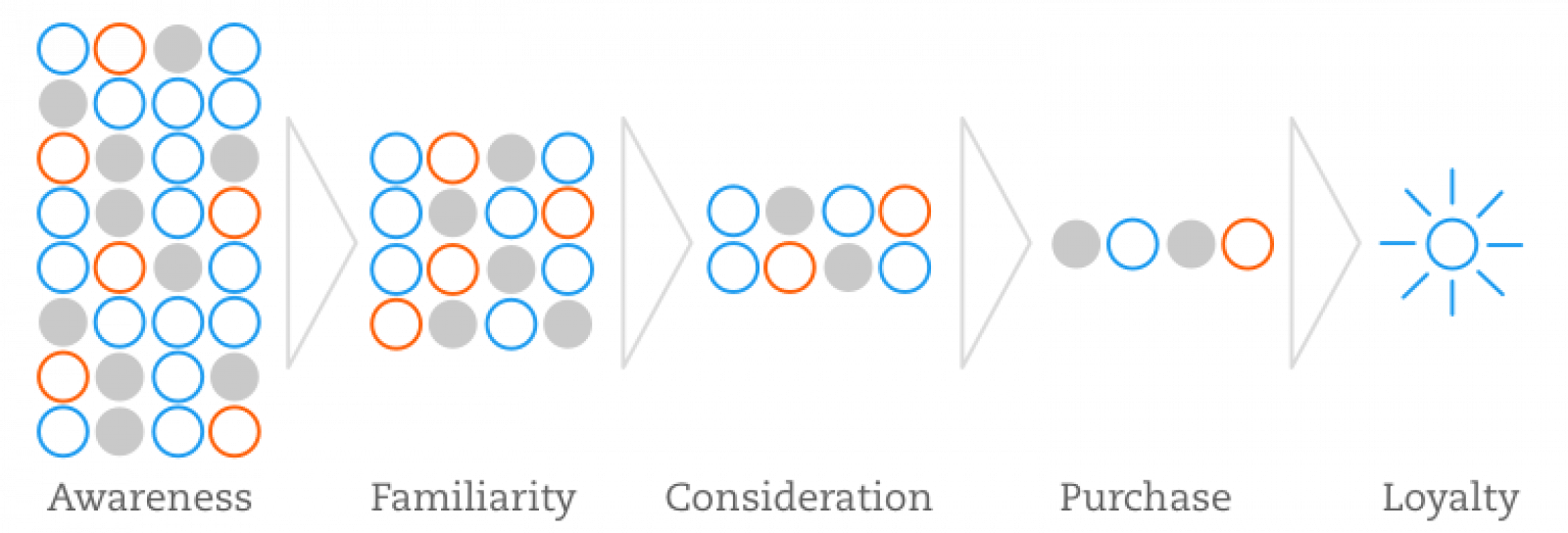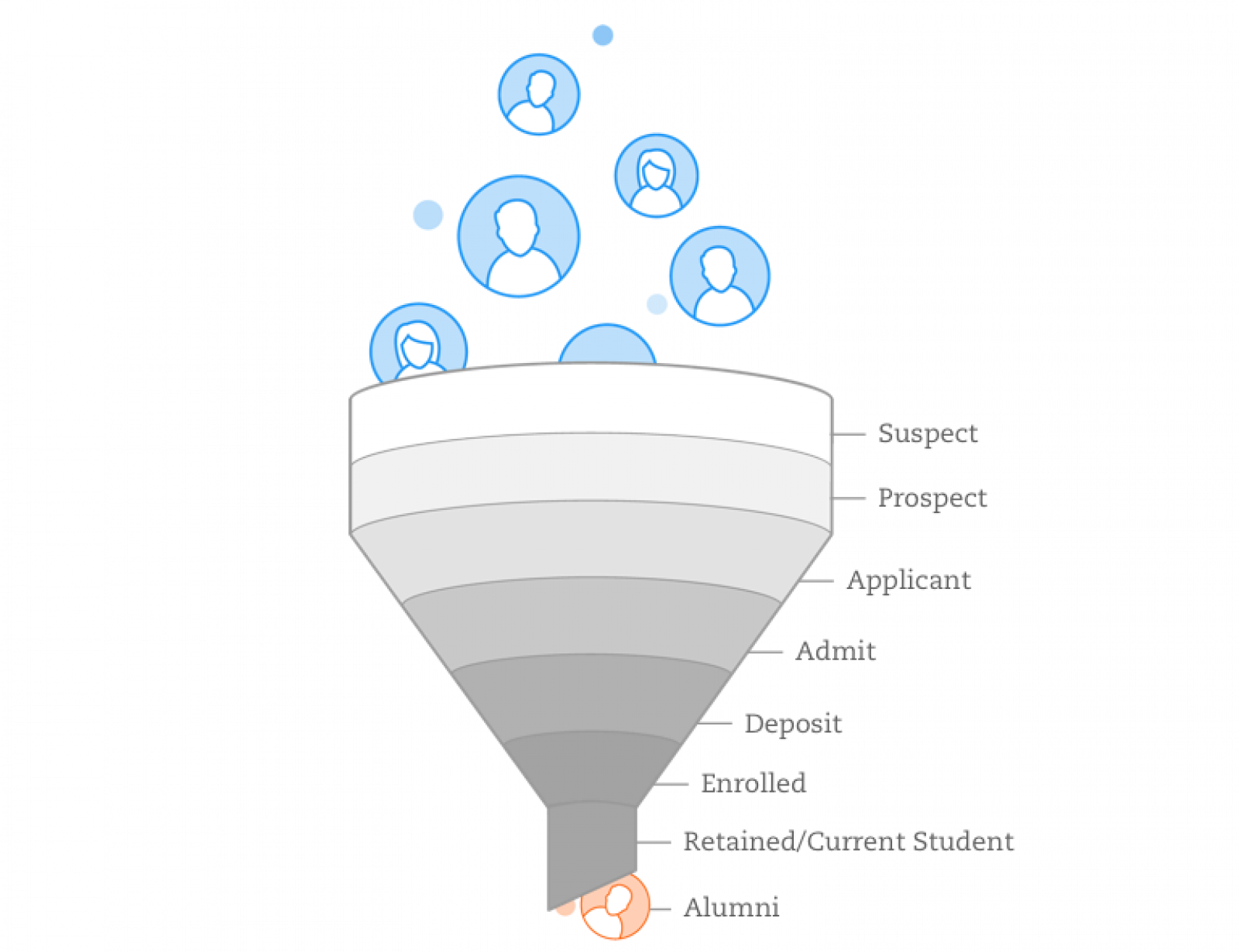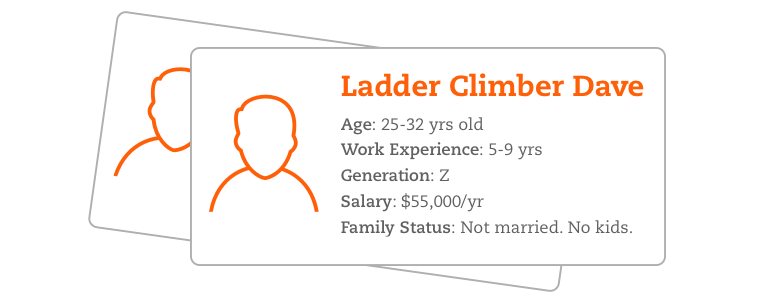The customer decision journey is the process customers go through when deciding whether to purchase a product or service.
In higher education, the enrollment funnel has long been the model used to drive marketing and admissions strategy. However, the funnel is only designed for the traditional enrollment cycle and its specific touchpoints, such as fall application deadlines or a May 1 deposit deadline. Prospect graduate students don’t adhere to a traditional enrollment cycle, thus, the funnel breaks down. The customer decision journey allows more flexibility for graduate enrollment management to maximize efficiency in marketing and recruitment tactics.

Stages of a Traditional Customer Decision Journey
This journey puts customers and their mindsets at the forefront. What are their needs? What are their motivations? What are their challenges? What are their important touchpoints with my institution and how can we make the most of them?
The funnel higher education marketers are accustomed to using is the enrollment funnel, i.e., the process prospective students go through when deciding whether to attend an institution.

Stages of the Traditional Enrollment Funnel
The enrollment funnel is action-oriented. Students move through the funnel as they meet certain criteria. Did they inquire? Did they apply? Did they deposit?
For marketers on the undergraduate side (specifically for traditional students), the enrollment funnel works because the enrollment cycle is filled with known variables. Students’ ages, goals, and motivations follow similar patterns. The length of time and affiliate benchmarks within the cycle stay consistent. There is a clearer checklist of “at this time, I need to deploy these tactics in order to deliver students the information they need.”
On the graduate side, the funnel is an incomplete model because the enrollment cycle does not follow the same patterns. Among the differences between undergraduate and graduate are the following:
- Time: Since we generally know when high school students start looking at colleges, we can map the process out from that initial search through their first day of classes, and sometimes even through graduation. The graduate process is different. The time between someone thinking about grad school to enrolling in classes can be as short as a few weeks or as long as several years.
- Age: Though the age range of prospective undergraduates varies to a certain degree with gap years, veterans, and other specialized groups, there generally is a more consistent age range for this group. On the graduate side, it’s not unusual for age ranges to span a couple of decades and cover a few different generations.
- Product*: In their college search, prospective undergraduates seek a coming-of-age experience. The products they’re considering are universities, whereas graduate students search for specific programs as a means to an end: more money, promotion, career prestige. The products they’re considering include universities, but aren’t limited to them. Competitors include free, online resources, networking, or even taking no action at all.
Key Benefits of Adopting the Customer Decision Journey
Graduate marketers can account for their non-traditional audience if they adopt the customer decision journey as the model, instead of the enrollment funnel.
This method spurs important changes to your marketing plans.
- Defining customer personas: Freeing yourself of the funnel helps define the customers’ motivations, needs, wants, and desires at each stage of the journey.
- Broadening your perspective: If prospective graduate students are considering options outside higher ed to accomplish their goals, then marketers need to consider those options as competitors.
How to Map the Journey for Prospective Grad Students
1. Determine and Create Customer Personas
Mine your CRM and conduct research within your customer base to create customer personas, “semi-fictional [representations] of your ideal customer based on market research and real data about your existing customers.”(Hubspot).
Customer personas break your audience into segments based on demographics, psychographics, behaviors, and more. (Not sure how to approach this? Spark451’s persona modeling services can help you transform your quantitative and qualitative data into actionable insights.)

- Background: Liberal arts degree. Working at the same company since graduation. Has on-the-job training in his work, but no formal training.
- Wants: A clear path toward prestige, promotions, and more money within his company and his field.
- Needs: To separate himself from others in the same situation. To build his résumé with real and impressive skills. To stay ahead of changes in the industry.
- Desires: Recognition. Impressive title. High salary. Prestige.
- His Obstacles: Time. Money. Motivation. Energy. Dave worries that grad school is too big an investment in time and money right now. He worries about balancing work and school and having the motivation and energy to do both well.
- Preferred Channels: Referral, email, forums/sponsored content. He is suspicious of anything that seems too sales-y.
2. Create Customer Journey Maps
Take each of your customer personas and design their journey map to determine targeting, messaging, and tactics at each stage.
Step 1: Awareness/Suspect
Dave feels frustrated and stuck in his career. He starts thinking about what he could do to climb the corporate ladder. He asks some friends for advice, visits some professional organization websites, searches for career coaches, looks up free online courses, and registers for the GRE.
How University X Meets Him
- Word of mouth (hopefully!)
- Free resources (courses, webinars, white papers, podcasts, video)
- Advertising
Step 2: Familiarity/Prospect
Dave feels a glimmer of hope. He sees that resources exist to help him, but he needs to figure out how much work he's willing to put in and how much money he can spend. While Dave is determining what he can do, he's researching what different products and companies can offer him.
How University X Meets Him
- Product demos
- Case studies
- Student/faculty/alumni profiles
- Testimonials
- Events
Step 3: Consideration/Applicant
Dave has decided that graduate school is the best choice for his lifestyle. It will give him the prestige of an advanced degree, teach him real skills, and keep him accountable. He focuses his search on only universities, starts his applications, and connects with admissions offices or program faculty.
How University X Meets Him
- Phone calls/SMS
- Live chat
- Meetings (in person or videochat)
- Coupons
- Invitations to attend classes
- Curriculum information
- Student outcomes
- Scholarships/funding
Step 4: Purchase/Enrolled/Current Student
Dave has chosen University X! He has enrolled in classes and is working toward his degree. He still worries about getting overwhelmed with working while taking courses.
How University X Meets Him
- Dedicated advisor
- SMS/email check-ins
- Surveys about experience
- Events
Step 5: Loyalty/Alumni
Dave had a great graduate school experience and has achieved the goals he set before enrolling. He wants ongoing professional development and the prestige of giving back to his alma mater.
How University X Meets Him
- Professional/networking events
- Career resources
- SWAG
- Donation rewards/recognition
The ways people make decisions remain the same, even while prospective graduate student behavior and the graduate education market both continue to evolve. Graduate marketers can adapt to changes quickly and effectively by shifting from the enrollment funnel to the customer decision journey. The team at Spark451 is ready to discuss your graduate enrollment challenges and help customize your marketing and recruitment strategies using a customer decision journey approach. Feel free to reach out so we can get started.